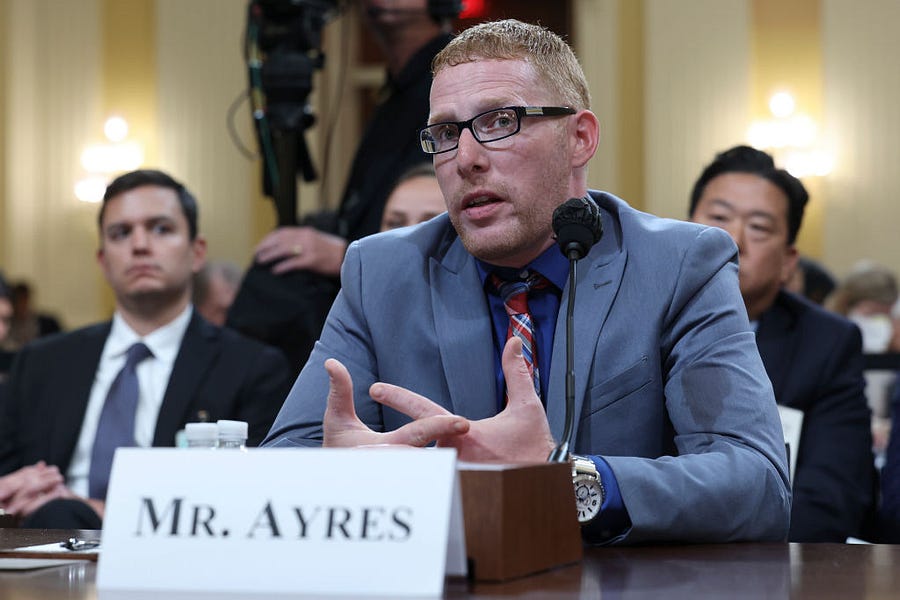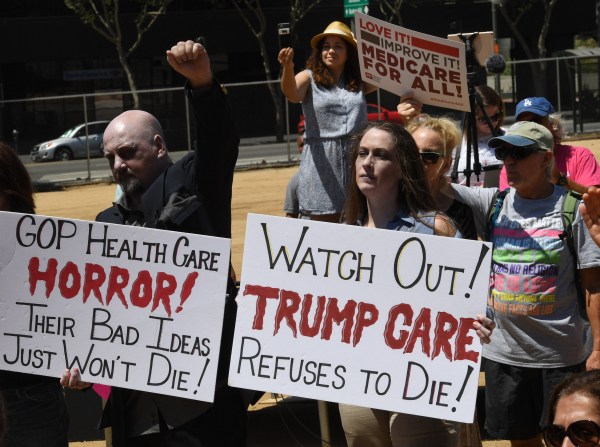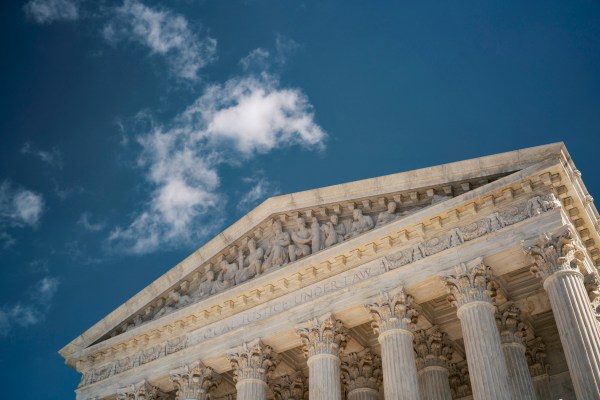When the House select committee investigating January 6 convened two weeks ago, the public heard what was arguably the most important testimony of the investigation thus far. Former White House aide Cassidy Hutchinson described her recollections of Donald Trump’s unhinged behavior leading up to and during the events of January 6, 2021, which included riling up a mob he knew in advance was armed and dangerous—behavior his closest advisers were largely ineffective at restraining, even when they tried.
Not every congressional hearing can be quite as revealing, and Tuesday’s took a more modest tack. Committee members reviewed what the public hearings have covered so far and previewed their plans for next week’s hearing, buttressing their case with new details and the compelling personal testimony of Stephen Ayres, a member of the mob that stormed the Capitol, and Jason Van Tatenhove, a former Oath Keepers associate. Committee vice chair Rep. Liz Cheney said the evidence presented suggests that former President Donald Trump was “substantially and personally” involved in the plot to overturn the 2020 election results and prevent the peaceful transfer of presidential power.
On December 14, 2020, the 538 members of the Electoral College met separately in each of the 50 states and cast their votes. For most of the Trump administration, that day marked the end of the road: They had lost, and it was time to prepare for whatever came next. Then-Labor Secretary Eugene Scalia told the committee in video testimony that he told Trump to concede on December 14. In tape of his deposition, Trump’s White House counsel, Pat Cipollone, said he agreed with Senate Majority Leader Mitch McConnell’s public comments the next day, December 15, when McConnell congratulated Joe Biden as “president-elect.” Other advisers shared similar sentiments. According to Cipollone, even Chief of Staff Mark Meadows was insisting around late November that Trump would make a graceful exit.
Trump disregarded this chorus of voices. As has been reported previously, Trump met in the Oval Office on December 18 with conspiracy-pushers, including Rudy Giuliani, Sidney Powell, and Patrick Byrne. One idea the group discussed involved a draft executive order—excerpts of which the committee displayed Tuesday—directing the secretary of defense to “seize, collect, retain and analyze all [voting] machines” and allowing for the presidential appointment of a special counsel to “institute all criminal and civil proceedings as appropriate.” This was, in Cipollone’s recorded words, a “terrible idea.”
Trump and his advisers opted not to pursue the idea—although Powell later seemed to believe Trump had appointed or intended to appoint her as special counsel on the matter—but Trump followed up the meeting with his now-infamous tweet: “Big protest in D.C. on January 6th. Be there, will be wild!”
Many of Trump’s supporters received that tweet, and the many that followed it in the weeks to come, as a call to action, promulgated across the pro-Trump, far-right online ecosystem on Twitter, YouTube, 8kun, thedonald.win, and other websites and platforms. In one notable video clip, commentator Matt Bracken declared that “we will only be saved by millions of Americans moving to Washington, occupying the entire area—if necessary, storming right into the Capitol. You know, we know the rules of engagement: If you have enough people, you can push down any kind of a fence or a wall.”
Stephen Ayres—who worked at a cabinet company in Ohio and described himself as a family man who enjoys playing basketball with his son in his free time—wasn’t planning on storming the Capitol when he came to Washington, D.C., for the January 6 rally. But he came in response to Trump’s call.
“I was, you know, pretty hardcore into the social media—Facebook, Twitter, Instagram,” he said. “… [Trump] basically put out, you know, come to the Stop the Steal rally … and I felt like I needed to be down here.”
While Trump was publicly calling the mob to D.C., he was also planning to march to the Capitol. As Meadows’ aide Cassidy Hutchinson testified previously, Trump thought he was going to go to the Capitol with his supporters after his speech on January 6 and had been agitating for such a move for days. Apparently the Stop the Steal rally organizers were also aware of Trump’s intentions. On Tuesday, the committee displayed a January 4, 2021, text message from rally organizer Kylie Kremer to MyPillow CEO Mike Lindell:
“This stays only between us, we are having a second stage at the Supreme Court again after the ellipse. POTUS is going to have us march there/the Capitol. It cannot get out about the second stage because people will try and set up another and sabotage it. It can also not get out about the march because I will be in trouble with the national park service and all the agencies. But POTUS is going to just call for it ‘unexpectedly.’”
Ali Alexander, another Stop the Steal organizer, sent out a text the following day.
“Trump is supposed to order us to the capitol at the end of his speech but we will see,” he wrote.
Trump considered announcing the march to the Capitol ahead of time, as evidenced by a draft tweet the committee obtained from the National Archives. The tweet—undated, but stamped as having been seen by the president—was never sent.
“The president’s own documents suggest that the president had decided to call on his supporters to go to the Capitol on January 6, but that he chose not to widely announce it until his speech on the Ellipse that morning,” committee member Rep. Stephanie Murphy said when presenting the tweet.
When Trump encouraged the crowd to march on the Capitol, Ayres decided to join.
“The president got everybody riled up and told everybody to head on down,” he said. “So we basically were just following what he said. … I was already worked up, and so were most of the people there.”
The next morning, after a tense phone call with Vice President Mike Pence, Trump reinserted previously deleted lines berating Pence into his speech draft, the committee said. During the speech itself, Trump ad-libbed further changes to his script to pressure Pence and spur the crowd.
“I hope Mike has the courage to do what he has to do,” Trump said. “And I hope he doesn’t listen to the RINOs and the stupid people that he’s listening to.”
“Would it have made a difference to you to know that President Trump himself had no evidence of widespread fraud?” Cheney asked Ayres during his testimony Tuesday.
“Oh, definitely,” he responded. “Who knows, I may not have come down here then.”
Ayres—who pleaded guilty last month to disorderly and disruptive conduct in a restricted building—deleted his social media after January 6. He told the House committee he no longer believes the election was stolen and is mad Trump is still lying about it. But Trump continues to influence millions of Republicans to this day.
Cheney made another explosive allegation as Tuesday’s hearing wrapped up: “After our last hearing, President Trump tried to call a witness in our investigation—a witness you have not yet seen in these hearings,” she said. “That person declined to answer or respond to President Trump’s call and instead alerted their lawyer to the call. Their lawyer alerted us and this committee has supplied that information to the Department of Justice. Let me say one more time: We will take any effort to influence witness testimony very seriously.”
In next week’s hearing, Cheney said the committee would walk through the events of January 6 “minute by minute.”






Please note that we at The Dispatch hold ourselves, our work, and our commenters to a higher standard than other places on the internet. We welcome comments that foster genuine debate or discussion—including comments critical of us or our work—but responses that include ad hominem attacks on fellow Dispatch members or are intended to stoke fear and anger may be moderated.
With your membership, you only have the ability to comment on The Morning Dispatch articles. Consider upgrading to join the conversation everywhere.